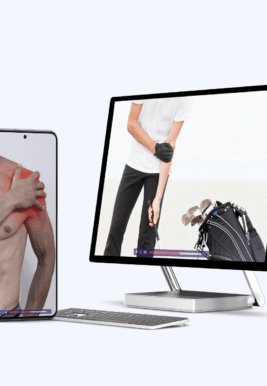Carpal Tunnel Syndrome | Diagnosis & Treatment

Carpal Tunnel Syndrome | Diagnosis & Treatment
Introduction & Epidemiology
The Carpal Tunnel is a passageway for the tendons of the flexor digitorum profundus & superficialis, flexor policis longus, and the median nerve enclosed by the hamate, trapezium, trapezoid, and capitate bone as well as the flexor retinaculum spanning from the trapezium to the hamate.
Carpal Tunnel Syndrome (CTS) is a syndrome or cluster of symptoms relating to pathology within the carpal tunnel and involves pain, neurological symptoms, and functional impairment of the hand.
Epidemiology
CTS or median nerve entrapment at the wrist is the most common entrapment neuropathy of the upper limb. The reported prevalence rate among women is 3% and 2% among men. Reports on the incidence vary from 324-542/100.000 in women to 166-303/100.000 in men (Atroshi et al. 1999, Gelfman et al. 2009).
It typically occurs between the age of 40-60 with a peak prevalence at 55 (Atroshi et al. 1999). Among pregnant women, the prevalence goes up to 62% (Ablove et al. 2009).
Pathophysiological mechanism
Oftentimes, the symptoms present in patients with occupations that involve repetitive and forceful hand tasks. This may result in swelling of the tendons narrowing the carpal tunnel and compromising the median nerve. Practically anything that can cause such narrowing may be a possible cause of CTS (Bekkelund et al. 2003, Kamolz et al. 2004, Middleton et al. 2014):
- Trauma: radial fracture, hemorrhage, carpal bone luxation
- Tumors: lipoma, ganglion, osteophytes
- Swelling of tendons
- Arthritis
Furthermore, there are risk factors associated with peripheral nerve pathologies such as CTS. These are pregnancy, obesity, hypothyroidism, renal failure, diabetes, and rheumatoid arthritis (Geoghegan et al. 2004).
Follow a course
- Learn from wherever, whenever, and at your own pace
- Interactive online courses from an award-winning team
- CEU/CPD accreditation in the Netherlands, Belgium, US & UK
Clinical Presentation & Examination
Signs & Symptoms
The cardinal signs of CTS are pain, paresthesia, and loss of motor control in the distribution of the median nerve. This includes pain, tingling, numbness in the thumb, index, and middle finger as well as the lateral part of the ring finger. Furthermore, weakness of the thumb, loss of grip strength, and varying degrees of loss of function, which is worsened nocturnally, are seen in CTS (Middleton et al. 2014).
It is also not uncommon that the symptoms occur bilaterally though this does not have to occur concurrently (Bagatur et al. 2001).
Physical Examination
Carpal Tunnel Syndrome may appear similar to radiculopathy in the distribution of cervical nerve roots C6 & C7. The differentiating factor is not only provocative testing of the cervical spine versus tests for CTS that we cover below, but an affected median nerve shows weakness and atrophy of the thenar and first two lumbrical muscles, which are innervated by C8-T1.
The most common tests are the Phalen’s test and the Tinel sign at the wrist. Wainner et al. (2005) have proposed a clinical prediction rule for the diagnosis of CTS. Watch the videos below to learn more.
Other common orthopedic tests to assess carpal tunnel syndrome are:
WATCH TWO 100% FREE WEBINARS ON SHOULDER PAIN AND ULNA-SIDE WRIST PAIN

Follow a course
- Learn from wherever, whenever, and at your own pace
- Interactive online courses from an award-winning team
- CEU/CPD accreditation in the Netherlands, Belgium, US & UK
Treatment
Both conservative and surgical treatments exist for CTS. The general consensus is that conservative treatment is initiated first before considering surgery (Middleton et al. 2014).
Erickson et al. (2019) have created an evidence-based guideline for the treatment of carpal tunnel syndrome:
A review by Burton et al. (2016) showed that 28-62% of patients recover without intervention, while 32-58% deteriorate. In patients following conservative treatment, 57% progress to surgery within 6 months and 62-66% undergo surgery in 3 years’ time. This is not exactly a very positive outlook for a patient suffering from CTS, so let’s look at evidence-based options to improve conservative rehab. A practice guideline from Erickson et al. (2019) evaluated different options and found weak to moderate evidence for the following options:
1) Avoidance/ Reduce nerve irritation
The first step in rehab for carpal tunnel can be to reduce or avoid movements and activities that cause further compression on the median nerve in the carpal tunnel. For patients working office jobs this could mean finding ways to reduce mouse use. This could be achieved by using arrow keys, and touch screens to alternate the mouse hand or to use a keyboard with reduced strike force for patients who report pain with keyboard use.
There is also moderate evidence for the effectiveness of wrist orthoses, which are based on several underlying theories such as reducing tendon and nerve movement through the carpal tunnel, immobilizing the wrist in a neutral position to achieve the least internal pressure, or increasing the space within the tunnel. A Cochrane review by Page et al. (2012) showed that patients using orthoses are three times more likely to report improvement than patients not using orthoses at 4 weeks. The wrist orthoses are usually worn at night, but wearing time can be adjusted to full-time use when night-only use is ineffective at controlling symptoms.
Additionally, we are recommending a common-sense approach to decreasing symptoms from CTS: Try to figure out which positions, activities and exercises lead to increased pain immediately or up to a day later. Ideally, try to write all information down in a diary and try to temporarily reduce those activities and positions. Commonly, these are activities that put the wrist into maximal flexion or extension, such as push-ups for example. Oftentimes, activities requiring a strong grip, such as tool use or pulling exercises might aggravate the condition as well. As soon as symptoms are under control and don’t worsen anymore, a graded activity program can re-expose patients to those activities again.
2) Manual Therapy
The guideline found weak evidence supporting the use of manual therapy interventions ranging from mobilizations to soft tissue techniques and stretching. A study by Fernandez-de-las-penas et al. (2017) found that Manual therapy and surgery had similar effectiveness for improving self-24 reported function, symptom severity, and pinch tip grip force on the symptomatic hand in 25 women with CTS.
Amongst others, they used the following techniques:
- Lateral glides at C5/C6 away from the symptomatic side (2 sets of 2 min each with 1 min break in-between)
- PA glides on C4 to C6, 30s bouts of grade III-IV for an overall time of 3min
- Neck stretches: Trapezius stretch, levator scapulae stretch, scalene stretch
While the interventions did not lead to an increase in cervical range of motion, complaints improved – possibly due to a stimulation of supraspinal pain inhibitory structures?
3) Nerve mobilization:
At the moment there is only conflicting evidence on the use of neurodynamic mobilizations in the management of mild to moderate CTS. If you were to use nerve mobilizations of the median nerve, it makes sense to use a less provocative slider first in the ULNT1 positions. Assess the reaction of the patient during treatment and the day after to find out if he or she is benefiting from the nerve mobilizations. Be careful as some patients might report an increase in pain the day after treatment. If your patient’s symptoms improve and he can tolerate it, you can move on to a more provocative nerve tensioner technique. Instead of moving the head towards the ipsilateral shoulder, the patient is now instructed to move the head to the contralateral shoulder. Both techniques can be done passively by the examiner, but also by the patient as a home exercise
4) Lumbrical stretching
Baker et al. (2011) compared the effectiveness of 4 different treatment combinations of orthoses and stretching. They found that a general orthosis at 0° of wrist flexion combined with the following lumbrical stretches were effective for improved function and reduction of disability and symptoms at 4, 12, and 24 weeks with only 25.5% of participants progressing to surgery.
The following 2 lumbrical stretches should be done 6 times per day:
- For the first stretch for the lumbricals, the patient rests his hand on the thighs palm down with the PIP and DIP joints fully flexed. Now he is asked to press down on the MCP joints with the opposite hand, to achieve full extension at the MCP joints and full flexion o the PIP and DIP joints.
- The second stretch is targeted at the flexor digitorum profundus. For this stretch, the MCP, PIP, and DIP joints are fully extended by pulling the wrist with the opposite hand
Perform each stretch for 7 seconds, 10 times per session, and 6 times per day.
All of the information can be watched in this video as well:
Do you want to learn more about elbow conditions? Then check out our other resources:
- Wrist & Elbow Injuries in Combat Sports with Ian Gatt
- Wrist & Elbow Injuries in Sports with Ian Gatt (Webinar)
- Carpal Tunnel Syndrome Guest Blog by Sian Smale
References
Bayramoglu, M. (2004). Entrapment neuropathies of the upper extremity. Neuroanatomy, 3(1), 18-24.
Geoghegan JM, Clark DI, Bainbridge LC, Smith C, Hubbard R. Risk factors in carpal tunnel syndrome. J Hand Surg Br 2004;29:315-20
Geoghegan JM, Clark DI, Bainbridge LC, Smith C, Hubbard R. Risk factors in carpal tunnel syndrome. J Hand Surg Br 2004;29:315-20
Illustration by: By OpenStax College – Anatomy & Physiology, Connexions Web site. http://cnx.org/content/col11496/1.6/, Jun 19, 2013., CC BY 3.0, https://commons.wikimedia.org/w/index.php?curid=30131518
Follow a course
- Learn from wherever, whenever, and at your own pace
- Interactive online courses from an award-winning team
- CEU/CPD accreditation in the Netherlands, Belgium, US & UK
Increase your confidence in assessing and treating the Hand & Wrist


What customers have to say about this course
- Senne Gabriëls30/12/24A complete understanding of elbow pathologies and management Very broad explanation of al the possible differential diagnosis and nice comprehensive management strategies with a big catalogue of exercises.Barbara14/12/24Really good Like always, perfect support to learn at your own rythm.
clear explanations and evidence based.
Thank you - Mika Tromp06/12/24Nice course! Explained the difference between osteoarthritis and rheumatoid arthritis nicely. Learned a few new things to use in clinical reasoning as well.Anneleen Peeters03/04/24Upper Limb Focus - The Wrist & Hand GREAT CONTENT!
Very happy with the way the course is presented; part videos, text and quizzes.
Great teachers, great refresher on the anatomy. - Dominik Meier01/04/24The Upper Limb Focus: Wrist & Hand CLINICALLY RELEVANT AND VERY WELL STRUCTURED COURSE!
This course is clinically relevant and very well structured. The wrist and hand is a very complex topic which has been described in a comprehensive and logical way. I can really recommend it. I like the theory and especially the cases. Thank you!Lieselot Longé29/12/23Upper Limb Focus - The Stiff Shoulder GOEDE CURSUS OM THUIS OP EIGEN TEMPO TE BEKIJKEN!
Dit is de 2de cursus die ik volg via physiotutors en net als de vorige cursus vond ik ook deze zeer leerrijk. Je krijgt dankzij deze cursus nieuwe inzichten in de behandeling van een stijve schouder. Er worden behandeltechnieken (o.a. mobilization with movement) getoond via video’s. Het leuke is ook dat je de cursus op je eigen tempo thuis kan volgen en na het afronden van de cursus kan je er nog steeds naar terug grijpen. Ik kijk ernaar uit om nog andere cursussen van physiotutors te ontdekken en raadt het ook anderen ten zeerste aan!. - Mieke Versteeg01/12/22Upper Limb Focus - The Elbow Inhoudelijk kwalitatief zeer hoogstaand.
Nog betere vertaling naar Nederlands zou toegevoegde waarde zijn.
Hulp per mail/telefonisch op ieder moment aanwezig/bereikbaar.




